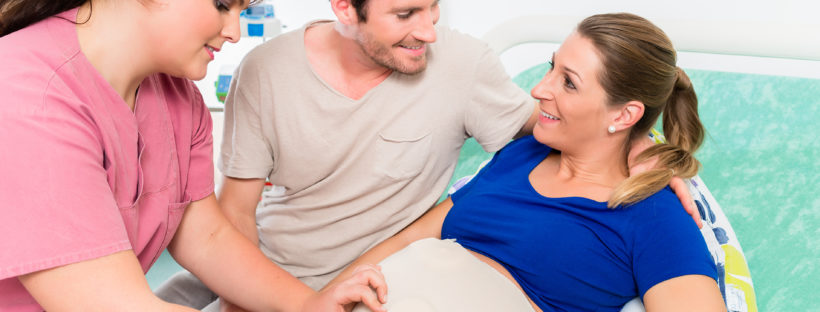By: Ann M. Mitchell, Holly Hagle, and Brayden Kameg
Prenatal exposure to alcohol can lead to a range of physical, mental, behavioral, learning, and developmental disabilities, with possible lifelong effects for the child exposed in utero. This range is commonly known as fetal alcohol spectrum disorder or FASD. FASDs are 100% preventable when a baby is not exposed to alcohol during pregnancy.
Healthcare professionals may tell women that it’s OK to drink alcohol on occasion or even in moderation, when they are pregnant. However, evidence shows that there is no known safe type, safe amount, or safe time to consume alcohol while pregnant.
Additionally, it’s important for healthcare professionals to broach the subject of alcohol consumption, not only with their pregnant patients, but with all women of reproductive age. Women who are sexually active and not using effective contraception may be at an increased risk for alcohol exposed pregnancies, as nearly half of all pregnancies within the United States are unplanned.
It is critical that healthcare professionals educate all women of reproductive age about alcohol use and pregnancy. Alcohol screening and brief intervention (alcohol SBI) is one evidence-based approach to assessing patients for at-risk alcohol use. Screening includes use of a validated tool, such as the Alcohol Use Disorders Identification Test (AUDIT). The AUDIT is a clinically reliable and valid instrument (Bohn, Babor & Kranzler, 1995). The AUDIT has been consistently found to screen and detect alcohol use across a spectrum of low, moderate, and high risk consumption (Reinert & Allen, 2007). The AUDIT has been found to be valid and reliable with diverse populations and in a variety of settings.
When a patient screens positive for at-risk use, a non-judgmental discussion, called a “brief intervention” occurs with the use of motivational interviewing techniques. For example, the patient is provided with the score on the AUDIT during the health care visit. If a patient scores between an 8 and 15, this score is discussed in relation to their current health condition and presented objectively to the patient as moderate alcohol consumption. If the AUDIT score is between 16 and 19, then brief counseling and continued monitoring are suggested. With a score of 20+ a referral for further assessment is indicated (Babor & Higgins-Biddle, 2001). The main goals of the brief intervention are to increase a patient’s awareness of their alcohol consumption patterns, understand the associated risks and options for reducing or eliminating those risks, and to increase their motivation to make healthy choices.
As nurses, it is our obligation to ensure that women are provided with the knowledge needed to make informed choices regarding their health. For example, giving the patient objective feedback about their score on the AUIDT and then asking them “What are your thoughts about this score?” is a way to elicit their thoughts and feelings about their alcohol consumption in relation to their health and wellness. Further, exploring the pros and cons of the patients current level of alcohol consumption is an excellent technique to elicit the patients thoughts and provides an opportunity for the health professional to provide feedback and health education. Patients have high trust in confiding to their healthcare provider and in particular nurses.
Additional Resources
Dr. Ann M. Mitchell is professor of nursing and psychiatry at the University of Pittsburgh School of Nursing. She is principal investigator on a CDC-funded project for the implementation of alcohol screening and brief intervention with the ultimate goal of preventing FASDs.
Dr. Holly Hagle is Director of Education for the Institute for Research, Education and Training in Addiction (IRETA) and a partner in the CDC-funded FASD project.
Brayden Kameg is a graduate student in the psychiatric-mental health nurse practitioner DNP program at the University Of Pittsburgh School Of Nursing. She is actively participating in grant-related activities on Dr. Mitchell’s projects.



 Amy is an ABSN student at MGH Institute of Health Professions, Boston. She was a stay at home mother for 12 years, a community coordinator for a non profit kids running program and a volunteer at Dana Farber Cancer Institute in Boston before deciding to enter the nursing field. With extensive volunteer experience from a camp for blind & visually impaired adults and children, to co-president of an elementary school PTO, she enjoys working with diverse groups of all ages. Amy aims to work in labor and delivery after graduation in August 2017 but is also interested in global health and epidemiology. She has intentions to keep making a difference in the lives of those she may never meet again.
Amy is an ABSN student at MGH Institute of Health Professions, Boston. She was a stay at home mother for 12 years, a community coordinator for a non profit kids running program and a volunteer at Dana Farber Cancer Institute in Boston before deciding to enter the nursing field. With extensive volunteer experience from a camp for blind & visually impaired adults and children, to co-president of an elementary school PTO, she enjoys working with diverse groups of all ages. Amy aims to work in labor and delivery after graduation in August 2017 but is also interested in global health and epidemiology. She has intentions to keep making a difference in the lives of those she may never meet again.